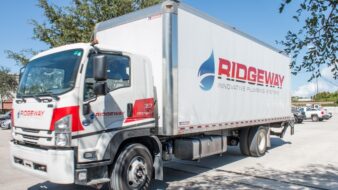Preparing 144 college apartments for the rigors of winter in Vermont is no easy task. Achieving it while also meeting the needs for a LEED Silver rating is a rather extraordinary accomplishment.

Now in their second winter at the University of Vermont’s “Redstone Lofts,” students have rated the apartments a “best-of” place to live while studying there.
In 2012, Williston, VT-based DEW Construction Corp., the construction manager (CM), broke ground on two new, state-of-the-art, on-campus student apartment buildings — Redstone Lofts — on land leased from the University of Vermont. The CM’s most challenging facet of the design was the integrated, super-efficient heating and cooling systems.
Extreme-green campus life
Following strict LEED guidelines, both of the new buildings were heavily insulated, and provide each living unit with its own HVAC system. The buildings also have high-albedo roofs, designed to reflect sunlight and heat, reducing roof temperatures.
All 144 living units are fully-furnished and range from one to four bedrooms in size. They also feature abundant natural light, which help to reduce electric costs (separately monitored so that occupants pay utility costs for their living unit), and low-e windows which are said to further reduce energy consumption by up to 24%.
Thermal energy transfer
 Water-source heat pump systems provide highly efficient zone-controlled heating and cooling throughout each building by circulating water in a closed loop piping system to move and exchange thermal energy. The many separate heat pumps in each building are connected to transfer BTUs with great efficiency.
Water-source heat pump systems provide highly efficient zone-controlled heating and cooling throughout each building by circulating water in a closed loop piping system to move and exchange thermal energy. The many separate heat pumps in each building are connected to transfer BTUs with great efficiency.
Compared to traditional two-pipe, central chiller — and boiler-based building systems, the installation of water-sourced equipment often saves 10 to 15% in the initial cost, or up to 20 to 30% of the installed cost when compared to a four-pipe system. And, with a thermal energy transfer system, maintenance needs are also typically low.
Individual heat pumps add or remove heat from the air within each zone as required to meet its unique heating or cooling load. During zone heating, they extract needed heat (thermal energy) from the common water loop. During zone cooling, heat is rejected into the water loop where it can then be shared with all other heat pumps throughout the building. It’s in this way that rejected heat — which is wasted to the outdoors in many HVAC systems — is fully utilized before any new energy source is used to heat or cool the building.

The design team stands next to the main heat source — two 95% efficient, 1-million BTU Laars NeoTherm boilers.
All buildings contain year-round sources of thermal energy, or internal heat gains, that can be recovered and recycled by a thermal energy transfer system, such as lighting (typically, 1 to 4 watts per square foot), people, (300 to 500 BTUs/hr.), equipment (computers, printers, copiers, pumps and motors), and solar gain. Perimeter zones with large, sun-exposed areas may require daytime cooling even during cold weather.
The heat pump systems also operate very efficiently under part-load conditions, such as when a small portion of the building remains occupied after hours. Only the required zone heat pumps are used, unlike systems that must keep a large central plant in operation at scaled-back capacity in order to serve a small portion of the load.
Efficient operation
“Each building’s mechanical room is equipped with two 95% efficient, 1-million BTU Laars NeoTherm boilers which serve as the main source of heat for fully-integrated water-sourced heat pump systems,” explained Tod Hebert, Laars regional sales manager.
Large, Baltimore Air Coil cooling towers serve as the source of heat rejection during warmer months to cool the heat pump loop and provide air conditioning.
“One of the more interesting facets of the mechanicals is the hydronic system, said Ed Pearson, president of Pearson and Associates Inc., the Redstone Loft’s mechanical, electrical and plumbing engineering firm. “The boilers are connected to an outdoor reset control, which monitors outdoor temperatures during the winter months to determine firing rates and frequency.”
“What we like about the NeoTherms is the ease of operation. They’ve got an advanced, intuitive control with touch screen right on the face of the boiler that tells users all about system operation and conditions within the buildings,” said David Cohen, territory manager of Stoughton, MA-based rep firm, Sales Marketing & Service, Inc.
“Paired with the Laars M4 controller mounted on the wall next to each boiler – the heating and hot water operations in the building are performed almost automatically. Very little has to be done to keep them going,” explained Steve Moruzzi, Laars territory service manager.
“I’m the only full time maintenance tech, and with over 400 tenants, the automated systems are a huge help,” added Blair.
“Every apartment and all of the common areas has its own McQuay water source heat pump,” explained Dan Gordon, foreman at Thomas Mechanical, Inc., plumbing and mechanical contracting company for the Redstone Lofts. There are a total of 156 heat pumps ranging in size from 1-1/2 to 2-tons for the apartments and up to 6-tons for common areas.
Each heat pump has its own compressor with a reversing valve, making them the sole providers for heating and cooling needs in each apartment.
According to Gordon, each living unit has exhaust and fresh air furnished by a Renew Aire energy recovery ventilator, which exhausts air from the bathrooms and kitchens and supplies fresh air. It conditions the fresh air by transferring energy from the exhaust air to the fresh air through an energy exhaust core. The fresh air never comes in contact with the exhaust air.
In each of the mechanical rooms are six, 120-gallon indirect water heaters to meet domestic hot water demand for each building. The boilers serve these as priority zones. “There’s a readily available source of domestic hot water at all times, which is extremely important during the winter conditions we experience,” said Blair.
For system heat, as needed during the winter months, hot water is injected into a flat plate heat exchanger which heats system fluids then circulate to individual heat pumps. The temperature of the boiler water is reset according to the outdoor air temperature. “This works seamlessly,” said Blair. “When system fluids hit 50 to 55 degrees, sensors activate the boiler. A Taco circulator then moves the BTUs out to any zones calling for heat.
“The circulation and control systems permit “self-serve” operation of the heat pumps as warmth or cooling are needed within the zone they serve,” explained Blair.
The heat pump loop is the key source of constantly-circulating BTUs. Loop water temperature ranges from 55°F (winter) to 90°F during summer months.
Each heat pump has its own zone valve that opens and closes to either pick up or reject heat into the main loop. When heat pumps are not calling for heating or cooling and the zone valve closes, the VFD-controlled Taco pump slows down, saving building energy.
“The boilers interaction with the loop water to keep the temperature in the required operating range for the heat pumps,” added Blair. “Each heat pump operates as its own zone, drawing-in or rejecting BTUs from the loop as needed.”
Another loop runs through a heat exchanger when cooling is required to one of two cooling towers in the parking lot; each building is served by a separate Baltimore Aircoil cooling tower.
According to Blair, each of the Baltimore Aircoil Cooling towers can provide a 13-degree cooling capacity of 145-gal./minute (with a 71-degree wet bulb temperature).
The total building BTUs for conditioned space amounts to an approximate 22 BTUs/square foot for heating, and 20 BTUs/square foot for cooling, though does not include some interior spaces such as stair towers and mechanical rooms.
Both building system sizes are the same as far as the number and sizes of heat pumps the water, boilers, storage tanks and cooling towers can support. The south building only has four floors; the north building has five floors, supporting the need for more apartment heat pumps.
In each mechanical room, four Taco 1900 series pumps — each dedicated to a boiler – circulate system fluids. A 1.5-HP Taco KV series pump governs domestic hot water circulation. Taco 2400 series circulators were installed as backups for the hot water circulation pumps. Both the loop system and cooling system pumps are Taco FI series pumps.
Controls – the system backbone
Eight Taco iWorx controllers act as the backbone for each building’s mechanical system, controlling the automation for all pumps and allowing the system to operate fluidly as a whole.
“Each controller manages different components of the HVAC system — whether it’s the air handlers, pumps, thermistors — you name it,” said Todd Daniels, Emerson Swan Distribution Sales rep for the state of Vermont.
“Taco’s modular iWorx controls give each mechanical component a module of its own, making it possible for the technician to easily program, diagnose and schedule all aspects of mechanical system operation.”
“iWorx makes maintaining and monitoring the mechanical systems a simple task. I can log in online with an IP address and see how each mechanical system is running,” explained Blair. “I don’t even have to step into the mechanical room to make changes to heat pump operation. I can be in my office working or out in the field; if anything goes wrong — a pump shuts off, or there’s higher static pressure that may indicate the need to replace a filter, or a sensor goes above a set point — I receive an email alarm that goes directly to my phone.”
In cases such as these, Blair can log in on his smart phone, turn pumps on or off, raise or lower temperatures, or perform a series of diagnostic procedures immediately. In most instances, we learn about problems before there’s any noticeable change of conditions within the living spaces — before they’re real problems.”
Although the polar vortex wreaked havoc all across the US, student tenants at Redstone Lofts had luxurious comfort, thanks to state-of-the-art technology.
“Not once have we received a complaint about loss of heat or hot water,” said Blair. “Even though last winter was one of the coldest we’ve seen in a long time, the systems kept up with the heating and hot water demands effortlessly.”






Join the conversation: